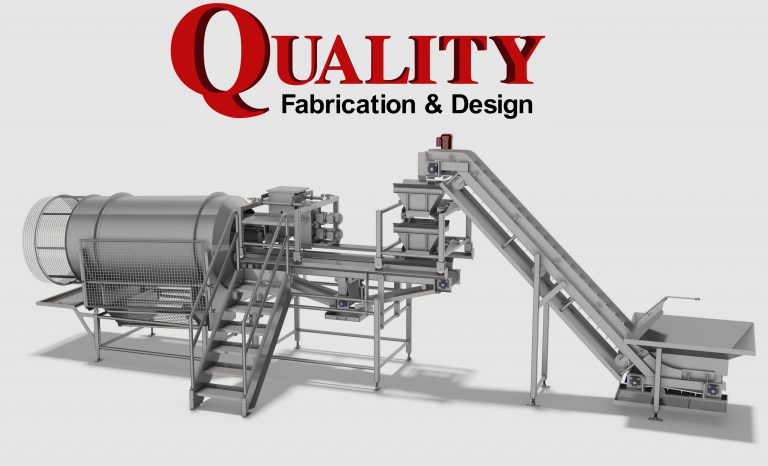Lose-In-Weight Seasoning System

Salty and Flavored Snack Seasoning System
Quality Fabrication & Design Loss-in-Weigh seasoning system application and sequence of operations performs as follows:
Product is discharged onto a weigh belt conveyor which receives tortilla chip product from another transfer conveyor. This weigh belt conveyor takes constant weigh readings as the product passes over the scale positioned below the belt. This weigh belt will send a signal to the PLC and Motor Control Panel to start and stop the seasoning drum, oil spray module, and the loss-in-weigh seasoner.
The PLC will send a signal to the oil spray module pump. Then the flow meter on the oil spray module will read the flow rate out of the pump and will send a signal to the PLC to increase or decrease the pump speed to maintain the required % of oil by weight being applied to the product based on the product weight into the seasoning drum. The loss-in-weigh seasoner will also receive a signal from the PLC that controls the RPM’s of the feed auger that impact the rate of change in the main hopper to feed the required % of seasoning being applied to the product based on the product weight into the seasoning drum. This accuracy saves oil consumption and seasoning/dry ingredient by the recipe application staying within the set range and aim specified by the customer.
Dry Rub Spice Seasoning Applicator
“Dry Rub” Spice Seasoning Application for the Poultry Industry The Quality Fabrication & Design, “DRY RUB” SPICE SEASONING APPLICATION system is designed to control not only the application rate of seasoning to the base product but also to control the rate at which the base product is being supplied into the seasoning application zone. This is critical in order to achieve absolute application coverage while maintaining a close tolerance percentage application rate. The base product is fed into the application via an INCLINE CONVEYOR feeding a WEIGH BUCKET rate controlling system. The WEIGH BUCKET acts as a check weigh unit in that it continuously monitors the rate at which the base product is being supplied.

The base product is fed into the application via an INCLINE CONVEYOR feeding a WEIGH BUCKET rate controlling system. The WEIGH BUCKET acts as a check weigh unit in that it continuously monitors the rate at which the base product is being supplied. This is done by the use of a load cell which in turns sends a signal back to a weigh monitoring device which passes weight information back to the supplied PLC. The PLC then uses a weight averaging calculation to determine the speed at which the INCLINE CONVEYOR should be running. By speeding up and slowing down INCLINE CONVEYOR, we are able to increase and decrease the rate at which the base product is being delivered. It is by this process that the desired set-point rate of base product is achieved.
The seasoning rate control is done in a similar yet different manner. It also uses load cells and a weigh monitoring device to send a signal to the supplied PLC for control rate calculations. The difference is that instead of the use of a check weigh system, the loss of weight (or Loss in Weight – LIW) as the seasoning is dispensed from the SEASONING FEEDER is monitored as a Rate of Change (or ROC) signal. Rather than totalizing and averaging weights, deviations of weights are measured along a time base and then averaged in order to determine the precise rate at which seasoning is being dispensed. The SEASONING FEEDER is equipped with an internal auger (or screw) which through the application of a turning motion feeds the seasoning through a tube (or snout) to be dispensed onto the base product. By speeding up and slowing down the rate at which the auger is turning, we are able to increase and decrease the rate at which seasoning is being delivered. It is by this process that the desired percentage set-point rate of seasoning is achieved.
Both the base product and seasoning are dispensed into a seasoning TUMBLER which performs the blending process by way of a tumbling motion. The TUMBLER is set at an adjustable angle which (along with RPM) controls the dwell time in which the blending process is performed.
Please give us the opportunity when the time comes to replace or add a fryer, or any other piece of processing equipment to your production line.
Quality Fabrication & Design is here to support your needs.
Pick up the phone and call Alex Pier at 972-304-3266, Ext. 402, or
e-mail me if you prefer at AlexPier@quality-fabrication.com
.…and remember… ”Quality, is just not our name, it’s the way we do things”
